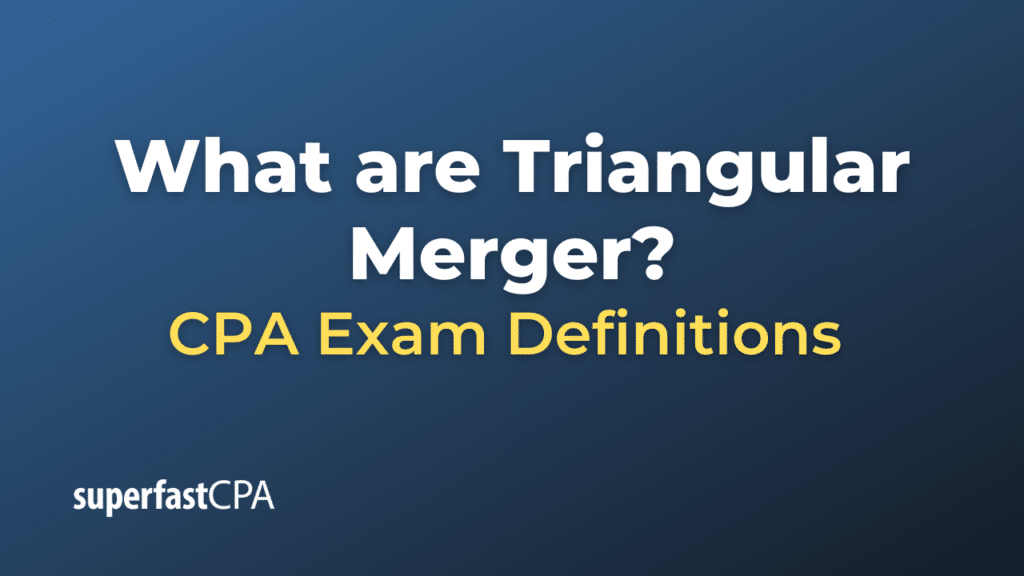Triangular Merger
A triangular merger is a type of merger involving three entities, typically two companies and a subsidiary. The process is structured so that one of the merging companies (the “acquiring company”) creates a subsidiary, which then merges with the target company. After the merger, the target company becomes a wholly-owned subsidiary of the acquiring company. The structure can be particularly useful for various strategic, financial, and tax reasons.
There are two primary types of triangular mergers:
- Forward Triangular Merger : In this setup, the newly-formed subsidiary of the acquiring company merges into the target company. As a result, the target company survives as a wholly-owned subsidiary of the acquiring company, and the subsidiary ceases to exist. Shareholders of the target company typically receive shares of the acquiring company or cash in exchange for their shares in the target company.
- Reverse Triangular Merger : Here, the target company merges into the subsidiary created by the acquiring company. The subsidiary remains as the surviving entity and becomes a wholly-owned subsidiary of the acquiring company. However, it’s the target company’s operations, assets, and liabilities that remain intact in the subsidiary. Shareholders of the target company typically receive shares of the acquiring company or cash in exchange for their shares in the target company.
Benefits of a Triangular Merger:
- Tax Considerations: One of the main advantages of using a triangular merger is related to tax considerations. In some instances, a triangular merger can be structured to be tax-free to the shareholders of the target company.
- Legal and Contractual Issues: Triangular mergers can also be used to sidestep certain legal and contractual issues that might arise in a direct merger. For instance, a target company might have contracts or debt agreements that could be triggered or violated by a direct merger but can remain intact in a triangular structure.
- Simplifying Complex Acquisitions: If the acquiring company is seeking to buy several different companies simultaneously, using triangular mergers can simplify the process.
- Flexibility in Payment: Triangular mergers offer flexibility in terms of the merger consideration (what the target’s shareholders receive). For instance, in some structures, the acquiring company might offer a mix of cash and stock, or entirely one or the other.
Despite these benefits, triangular mergers can be complex and involve various regulatory, tax, and legal considerations. As such, companies considering such a structure often work closely with legal and financial advisors to ensure they navigate the process appropriately.
Example of a Triangular Merger
Let’s illustrate a triangular merger using a hypothetical example:
Scenario: TechGiant Inc., a major tech corporation, wants to acquire StartUp Co., a smaller innovative firm with unique software patents. Due to certain existing contracts and beneficial tax implications, TechGiant Inc. doesn’t want to acquire StartUp Co. directly.
Solution: TechGiant Inc. opts for a reverse triangular merger.
Steps:
- Formation of a Subsidiary : TechGiant Inc. creates a wholly-owned subsidiary called “TechSubsidiary” for the purpose of this acquisition.
- Merger: StartUp Co. merges into TechSubsidiary. After the merger, StartUp Co. ceases to exist as a separate entity, and TechSubsidiary remains, holding all of StartUp Co.’s assets, liabilities, and operations.
- Shareholder Compensation: The shareholders of StartUp Co. receive shares of TechGiant Inc. (or a combination of shares and cash) in exchange for their shares in StartUp Co.
- Outcome : TechSubsidiary, containing all the operations and assets of the formerly standalone StartUp Co., is now a wholly-owned subsidiary of TechGiant Inc. TechGiant Inc. has effectively acquired StartUp Co. without a direct merger, and the existing contracts of StartUp Co. remain undisturbed.
In the real world, the exact terms, pricing, and structure of such deals would be based on negotiations, due diligence, legal considerations, tax implications, and strategic fit.













